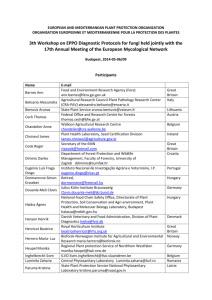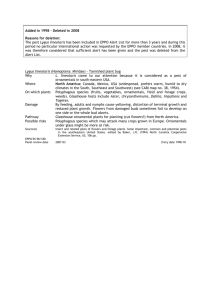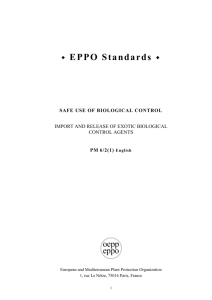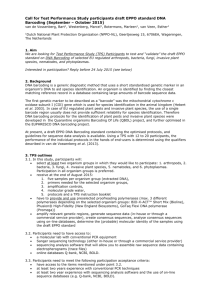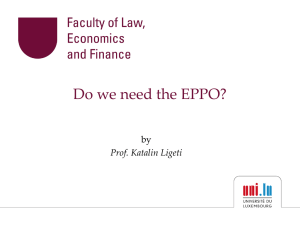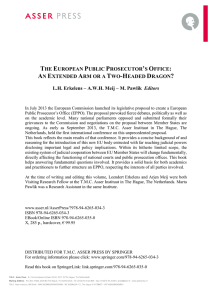EUROPEAN AND MEDITERRANEAN PLANT
advertisement
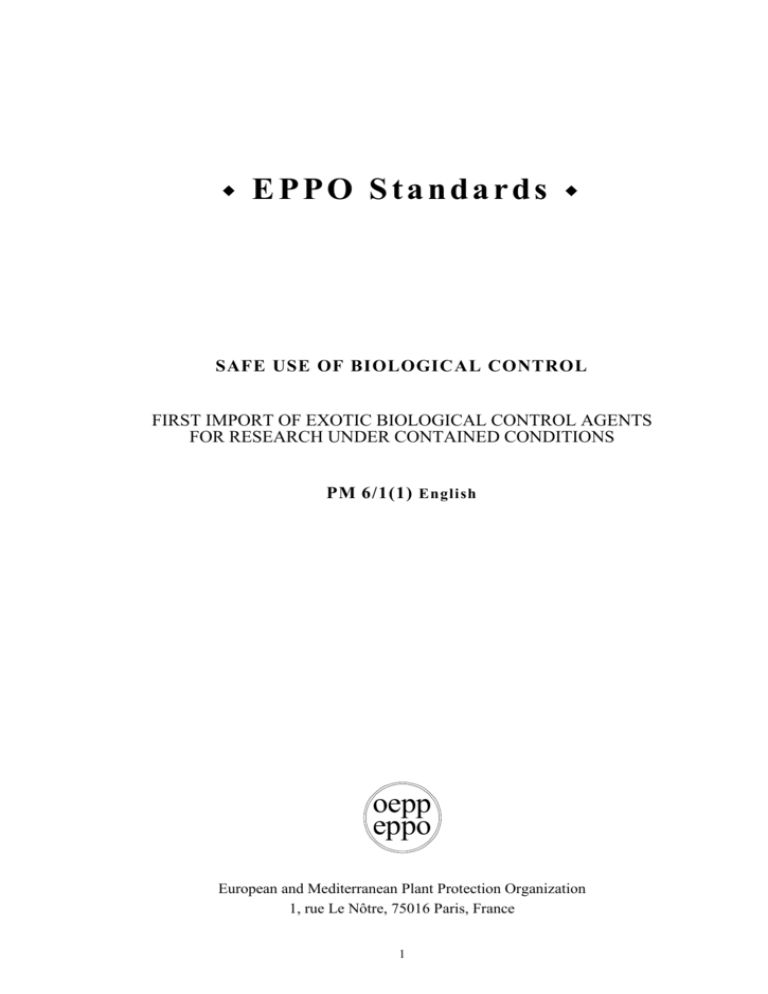
EPPO Standards SAFE USE OF BIOLOGICAL CONTROL FIRST IMPORT OF EXOTIC BIOLOGICAL CONTROL AGENTS FOR RESEARCH UNDER CONTAINED CONDITIONS PM 6/1(1) English oepp eppo European and Mediterranean Plant Protection Organization 1, rue Le Nôtre, 75016 Paris, France 1 APPROVAL EPPO Standards are approved by EPPO Council. The date of approval appears in each individual standard. In the terms of Article II of the IPPC, EPPO Standards are Regional Standards for the members of EPPO. REVIEW EPPO Standards are subject to periodic review and amendment. The next review date for this set of EPPO Standards is decided by the EPPO Working Party on Phytosanitary Regulations. AMENDMENT RECORD Amendments will be issued as necessary, numbered and dated. The dates of amendment appear in each individual standard (as appropriate). DISTRIBUTION EPPO Standards are distributed by the EPPO Secretariat to all EPPO Member Governments. Copies are available to any interested person under particular conditions upon request to the EPPO Secretariat. SCOPE The EPPO Standards on the safe use of biological control are intended to be used by NPPOs or equivalent authorities, in their capacity as bodies responsible for overseeing and, if appropriate, regulating the introduction and use of biological control agents. REFERENCES IPPC (1995) Code of Conduct for the Import and Release of Exotic Biological Control Agents. ISPM no. 3. IPPC Secretariat, FAO, Rome (IT). OUTLINE OF REQUIREMENTS NPPOs of the EPPO region generally promote the use of biological control in plant protection as, like other aspects of integrated pest management, it reduces risks for human health and the environment. Use of biological control agents may, nevertheless, present some risks, in particular for the environment if exotic agents are introduced from other continents, and for the user if agents are formulated as plant protection products. In general, the latter case can be covered by EPPO Standards of series PP, concerning plant protection products. The aim of the EPPO Standards on the safe use of biological control is to provide the NPPOs with guidelines for assessing and reducing the risks associated with various aspects of the introduction and use of biological control agents and, as appropriate, for comparing them with the benefits in terms of efficacy. The EPPO Standards seek to make the administrative framework for the introduction and use of biological control agents as light as practically possible, in order to sustain a general policy of promotion of biological control. 2 EUROPEAN AND MEDITERRANEAN PLANT PROTECTION ORGANIZATION ORGANISATION EUROPEENNE ET MEDITERRANEENNE POUR LA PROTECTION DES PLANTES PM 6/1(1) English Safe use of biological control FIRST IMPORT OF EXOTIC BIOLOGICAL CONTROL AGENTS FOR RESEARCH UNDER CONTAINED CONDITIONS Specific scope Specific approval and amendment This standard gives guidelines for the first import of exotic First approved in September 1999. biological control agents for research under contained conditions. ______________________________ Introduction The notification procedure should be followed before the first import of a given organism from a given origin. Generally, it is not necessary to notify again in detail if further imports of the same organism are made from the same origin, unless there are new circumstances. It may, however, be useful to report such imports to the national authority. If another research organization makes an independent import, it should notify as for a first import. Exotic1 organisms may pose risks to agricultural and natural ecosystems if they establish in the environment, and their introduction into countries should be done with great care. Research organizations may wish to import exotic organisms to investigate their prospects as biological control agents. If this research extends to release in glasshouses or in the field, it carries a risk almost as high as full-scale release (see EPPO Standard PM 6/2). If, however, it is conducted under contained conditions, it carries a lower level of risk. This standard is concerned with this case. In general, the IPPC Code of Conduct for the Import and Release of Exotic Biological Control Agents (IPPC, 1995) serves as the model for this. It provides that governments should designate a national authority responsible for implementation. For the purposes of first import of biological control agents under contained conditions, this national authority should institute an official notification procedure. The administrative procedures required to establish such a procedure, including the necessity or otherwise for a legal framework, will vary from country to country. The importing organization should notify the national authority of its intention to import exotic organisms for research under contained conditions, and the national authority should react to the notification by providing relevant guidance. The national authority may advise whether the import is useful (a real potential benefit to the community is to be expected) and can be made safely. At the time of import, many biological characteristics of the organism, such as climatic requirements and exact host range, may not be known, nor will it be clear in what manner the organism will be used for biological control. It is the purpose of the research to determine this. As a result, the initial notification can only meet minimum requirements for information, as given below in this standard. 1 Notification The research organization which intends to import the organism should first evaluate the safety of the import and should prepare a dossier for submission to the national authority. This dossier should include: 1 the name and address of the organization concerned, and the names of the persons planning to conduct the research; 2 the purpose of the research and the potential benefits; 3 a description of the containment facilities proposed for the research; 4 accurate identification of the organism or, if it has not been identified, suitable characterization to allow its unambiguous recognition; 5 details of the proposed import (amount and form of the organism, ultimate origin, immediate source); 6 whether the organism was collected from the wild (with greater risk of presence of contaminants and hyperparasites) or reared in the laboratory; 7 information, if available, on host range, previous use in biological control, experience of environmental impact; 8 information on earlier imports, by whom and with what results; 9 a conclusion on risks for agricultural and natural agrosystems. The term "exotic" excludes organisms which are indigenous to the country or which have been introduced and have established. 3 Guidance The national authority should examine the notification and provide, within a reasonable time, a brief reply, giving appropriate guidance to the research organization. This may relate to: 1 the advisability of conducting the research in the manner proposed; 2 suitable containment facilities, including quarantine if necessary; 3 procedures to be followed if contaminants or hyperparasites are likely to be present; 4 procedures for destroying the organism and terminating the research. General safeguards In general, the following precautions should be taken when the organism is imported: 1 packages should be properly labelled and suitable information prominently displayed on the outside of the package to inform those handling it of the contents; 2 advance notice of the content of the package (with full details of routing) should be provided to those handling it and the receiver, to minimize delays and alert those concerned; 3 risks to animal and human health should be considered, and all appropriate regulations should be respected; 4 biodiversity conventions should be respected. 4
